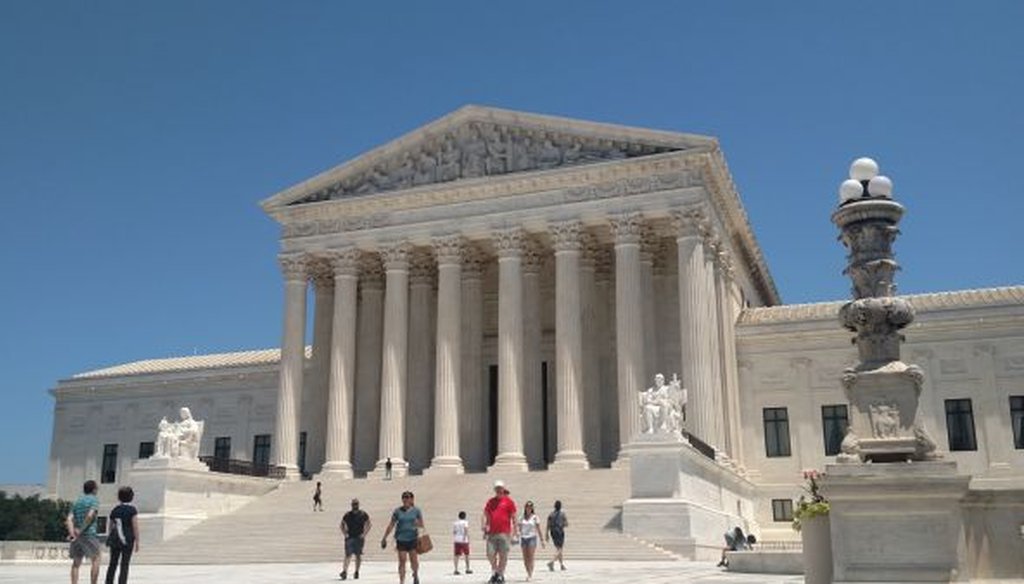Stand up for the facts!
Our only agenda is to publish the truth so you can be an informed participant in democracy.
We need your help.
I would like to contribute

The Supreme Court in Washington, D.C. (Louis Jacobson, PolitiFact)
North Carolina’s nationally watched gerrymandering lawsuit won’t change the political landscape for the 2020 elections and beyond, after a U.S. Supreme Court decision Thursday.
But another case might.
This is not the first time North Carolina has made national news for a court case about its election districts. In fact, North Carolina has a long history of gerrymandering.
Here’s everything you need to know about what’s going on with political maps in North Carolina.
North Carolina’s contorted history of congressional redistricting
What is gerrymandering?
Every 10 years, after the Census, state political boundaries are redrawn to account for population changes.
Gerrymandering is the practice of drawing those boundaries to benefit a party or group. While it may seem like a new problem, it isn’t. The term "gerrymander" dates back to an 1812 redistricting plan signed into law by Massachusetts Gov. Elbridge Gerry that was so irregular, the district looked like a salamander. Gerry + Salamander = Gerrymander.
Since 1812, gerrymandering has grown and become a more sophisticated practice — especially with the influence of modern technology, which has made it ruthlessly precise."It’s something that we’ve always had, but it’s getting worse because in the past you didn’t have the data, you didn’t have the technology, you were literally drawing maps by hand." Michael Li, the senior counsel for the Brennan Center’s Democracy Program, said in a phone interview. "You didn’t have the robust data you have now. You could have some effect, but it wouldn’t necessarily last all decade."
While seen by critics as anti-democratic, gerrymandering is not currently illegal — with the exception of racial gerrymandering, which dilutes the influence of voters of certain races and is prohibited by the Voting Rights Act. North Carolina is in the spotlight because of a series of partisan gerrymanders.
Gerrymandering in North Carolina
In North Carolina, members of the General Assembly draw the maps for their own elections to the state House and Senate as well as for federal elections to the U.S. House. The maps don’t need the governor’s approval.
North Carolina is no stranger to improper gerrymandering. In the 1990s and 2000s when Democrats were in control of the General Assembly, multiple redistricting plans were struck down as unconstitutional racial gerrymanders. This included the "I-85 district," a racial gerrymander that stretched 160 miles from Durham to Charlotte.
In 2010, Republicans took control of the legislature, so they were responsible for redrawing congressional and state legislative districts for the next decade.
In a 2016 case affirmed by the U.S. Supreme Court called Cooper v. Harris, North Carolina’s 2011 congressional maps were struck down as racial gerrymanders. Republican legislators were required to draw new lines in February 2016. These districts were eventually brought to the U.S. Supreme Court in Rucho v. Common Cause.
A year later, North Carolina’s state House and Senate maps were also brought to court and ruled to be unconstitutional racial gerrymanders. These maps were redrawn in September 2017. The 2017 maps are being contested in the next big case: Common Cause v. Lewis.
What happened in the Supreme Court?
Thursday’s U.S. Supreme Court ruling was a victory for North Carolina Republicans accused of unconstitutional partisan gerrymandering in Rucho v. Common Cause and for Democrats facing similar accusations in Maryland.
The North Carolina case originated last year when a three-judge panel struck down the Republican-drawn congressional map from 2016 as an unconstitutional partisan gerrymander. When the General Assembly met to pass that congressional map, Republican Rep. David Lewis, co-chair of the elections committee responsible for the alleged gerrymander, said he believed "electing Republicans is better than electing Democrats."
"I propose that we draw the maps to give a partisan advantage to 10 Republicans and three Democrats because I do not believe it’s possible to draw a map with 11 Republicans and two Democrats," Lewis said at the time.
Out of 13 House seats up for election in 2018, Republicans claimed 10, even though Republican candidates received just 50.3 percent of the vote. (One GOP victory, in the 9th district, was invalidated after allegations of election fraud; a new election is underway.)
Thursday, the Supreme Court overturned the three-judge panel’s ruling and said determining how much partisan gerrymandering is too much is beyond the courts’ authority.
Partisan gerrymander at the state level
The fight against partisan gerrymandering in North Carolina is not over yet. Common Cause v. Lewis, contesting the 2017 state House and Senate districts, goes to court on July 15.
This case, too, recently made national news, after computer files belonging to a deceased Republican strategist, Thomas B. Hofeller, were turned over to the challengers in the case.
While the Republicans lost six seats in the state Senate and 10 seats in the state House in the "blue wave" of 2018, ending their supermajorities in both chambers, they still maintained a majority in both.
Republican legislators unsuccessfully tried to move the case to federal court, saying in a news release that they did not want the case to be heard in North Carolina because they thought the judges there may be too liberal to give them a fair trial. The state Supreme Court currently leans heavily Democratic; the appointment of Mark Davis to the court gave Democrats a 6-1 majority. In contrast, the U.S. Supreme Court has a majority of conservative-leaning justices.
This case will go to trial in Wake County Superior Court, where the plaintiffs will ask for partisan gerrymandering to be ruled unconstitutional under the North Carolina Constitution.
What does this mean for the 2020 election?
Nationally, partisan gerrymandering will remain unchecked for now.
The U.S. Supreme Court case had the potential to set a national standard for partisan gerrymandering, said Pope McCorkle, a professor in Duke University’s Sanford School of Public Policy who has served as a political-issues consultant.
"If the Supreme Court doesn’t act, I think people will understand that there really are no limits… and basically, that will be a signal that the police are not on the block," McCorkle said before the Supreme Court opinion came out.
The state and federal cases are not dependent on one another since they are taking places in two different courts, said Bob Phillips, executive director of Common Cause North Carolina. While it has sometimes been called liberal-leaning, Common Cause says on its website that it is "a nonpartisan, grassroots organization dedicated to upholding the core values of American democracy." Common Cause also supported the lawsuit over Maryland’s Democratic-drawn districts.
North Carolina’s state and federal cases "are definitely on two different tracks, and in our minds, two bites into the same apple," Phillips said.
This means that while Rucho v. Common Cause did not result in redrawn congressional districts, Common Cause v. Lewis could be successful in obtaining new districts for the state legislature.
Redrawing the districts would make them more competitive — especially in the state legislature, where the two parties have already been more closely matched in recent years, Phillips said.
"This adds maybe more uncertainty to what the 2020 election outcome would be, and most importantly, who controls the General Assembly," Phillips said.
Redistricting before the 2020 elections would only be effective up until the 2020 census, after which the state will be redistricted again for the 2022 elections.
This story was produced by the North Carolina Fact-Checking Project, a partnership of McClatchy Carolinas, the Duke University Reporters’ Lab and PolitiFact. The NC Local News Lab Fund and the International Center for Journalists provide support for the project, which shares fact-checks with newsrooms statewide. To offer ideas for fact checks, email [email protected].
Our Sources
"North Carolina Redistricting Cases: the 1990s" by the Redistricting Task Force for the National Conference of State Legislatures, July 8, 2003
Phone interview with Dustin Chicurel-Bayard, communications director at the Southern Coalition for Social Justice, June 13, 2019
Phone interview with Bob Phillips, executive director of Common Cause North Carolina, June 13, 2019
Phone interview with Michael Li, senior counsel for the Brennan Center’s Democracy Program, June 18, 2019
Phone interview with Pope McCorkle, a professor at Duke University’s Sanford School of Public Policy, June 18, 2019
"Supreme Court will hear NC gerrymandering case soon, potentially breaking new legal ground" by Will Doran, January 4, 2019
"Two gerrymandering cases that could shape the 2020 elections are ramping up in court" by Will Doran, December 21, 2018
"The Supreme Court won’t overturn NC’s congressional maps. Will lawmakers act?" by Will Doran, June 27, 2019



























